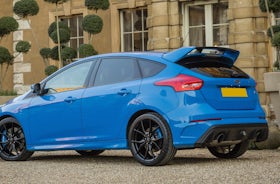Ford Focus RS Review and Prices
This is the Focus RS tasked with taking the fight to the Volkswagen Golf R, which is slower, plus the Audi RS3 and Mercedes A45 AMG, both of which cost quite a lot more.
- Used
- £20,197
What's good
What's not so good
Find out more about the Ford Focus RS
Is the Ford Focus RS a good car?
If anything, this new Focus RS has more in common with the picnic-table-winged Escort RS Cosworth than the previous Focus RS as it too is four-wheel drive. Power comes from a four-cylinder 2.3-litre petrol engine that also stars in the new Ford Mustang. It pumps out 350hp – helping make this the fastest Focus ever sold. If that seems like a small number, independent tuner Mountune can take it up to 375hp for £1,050.
Although the four-wheel-drive system is worthy of note, it’s what Ford has done with it that is really exciting. Instead of giving the Focus a super-planted setup, the firm’s gone the other way – using high-tech mechanicals and clever electronics to make the car easy to slide and, by virtue of this – a hoot to drive. It’s fun in a way that its accomplished rivals – the Audi RS3, Mercedes A45 AMG and Golf R – have never quite managed.
This is not only a really fast car both on road and on track – it’s also amazingly good fun
A comprehensive aero kit is tasked with ensuring your RS is never mistaken for the 1.5-litre diesel model driven by your elderly neighbour. It amounts to a deep front bumper, rear diffuser and boot-lid-mounted spoiler that not only looks good, but also helps with stability, while the gaping grille keeps the engine cooled.
What’s likely to be one of the RS model’s biggest lures is a price that undercuts all of its rivals – some by a considerable margin.
To see what sort of offers are available on the Focus RS, look at our deals page.
How much is the Ford Focus RS?
The Ford Focus RS has a RRP range of £34,155 to £41,285. The price of a used Ford Focus RS on Carwow starts at £20,197.
How practical is it?
The Ford Focus looks after its driver very well, and it’s pretty good for passengers, too. The only price you pay in practicality is that the four-wheel drive system takes up some of the boot space
People will concentrate on the extra performance and sharper handling in the RS, but it's impressive how Ford has done all that and still left the Focus as a usable family car
What's it like to drive?
Spark up the engine and the raspy note emitted from the car’s pair of chubby exhaust pipes gives some idea of the onslaught that’s set to come.
The engine is from the Mustang but has a bigger turbo
What's it like inside?
If we were in an uber-harsh mood, we could say the Focus RS’ reasonable price is reflected by the reasonably unexciting interior.
Ford Focus RS colours
-
Solid - Deep orange
- Free
-
Solid - Race red
- Free
-
Solid - Stealth grey
- Free
-
Special metallic - Nitrous blue
- Free
-
Special solid - Frozen white
- From £250
-
Metallic - Magnetic
- From £525
-
Mica - Shadow black
- From £525
- Used
- £20,197








